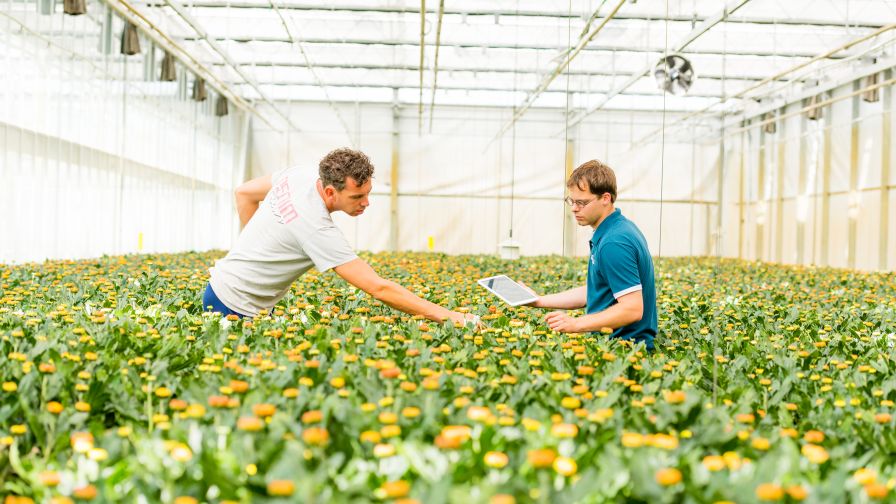Ways AFE Research Support Benefits the Horticulture Industry

Research supported by American Floral Endowment has helped growers manage a range of pest issues, including thrips control. Photo; Terrill Nell AFE
Twenty-seven years ago, I wrote about the state of floriculture programs at the university level. At that point as a nation, we were in the depth of recession, and budget belt tightening was taking no prisoners, hitting every level of government — local, state, and federal. In the midst of dwindling dollars dedicated to floriculture programs, we watched long-standing beacons of floriculture research, Extension, and teaching disappear almost overnight. The go-to programs —and the people associated with them — were no more. The outlook was grim.
When I wrote that article in 1992, I was a Professor of Floriculture at the University of Florida in Gainesville. Today, I’m writing as the American Floral Endowment’s Research Coordinator. Due to my position, I have a finger on the pulse of floriculture research efforts. If I could share just one thought about that pulse, I’d tell you it’s beating strongly.
Our industry’s growers are remarkable, resilient individuals who grasp the need for partnering with researchers to accomplish common goals. Floriculture research helps fuel the industry’s growth and development, and I’m happy to say that through the work of the American Floral Endowment (AFE), the outlook for research is bright.
Changes and Challenges
As we stare down the next decade, no industry is without changes and challenges. In 1982, Buckminster Fuller (American architect, author, inventor, and systems theorist) coined “The Knowledge Doubling Curve.” He noted that accumulated and transmitted human knowledge doubled at an exponential rate. For instance, from 1750 to 1900, human knowledge doubled. By the end of World War II (1945), the rate of doubling had dropped to 25 years, and by the 21st Century, the figure fell to 18 months. Recent estimates put the rate of knowledge doubling at every 12 hours.
That rapid rate of knowledge accumulation affects every area of life, and our industry is no exception. Each area of change brings a range of challenges we must address as an industry. Some of the changes we’ve seen in the last few years include:
- Industry consolidation: It’s a strong trend, with some greenhouses closing as other growers expand.
- New crops: We celebrate new additions that grab market share, but new plants also bring a host of new challenges. Everything (height control, flowering, pest management, etc.) has to be worked out.
- Environmental concerns: Sustainable production is here to stay. As an industry, we have learned (thanks to AFE-funded research) to produce our crops with reduced water and fertilizer. We must continue to control runoff from operations and learn to recycle water even more efficiently and effectively, without spreading disease.
- Flower shelf-life: Both retail outlets and consumers bring expectations of long-lasting flowers and plants. As an industry, we must continue to address postharvest issues to deliver the long life that customers desire.
How AFE Works for You
The way AFE works is simple. We foster partnership, through research grants, for high priority issues facing the industry. Through grower feedback, AFE targets issues facing the floriculture industry and provides grant money to researchers willing to find solutions to the problems.
AFE research has been transformative. This type of research that’s funded by the industry yields innovative modifications and guidance in flower production, shipping, and handling. Examples include controlling plant height with temperature and graphical tracking (Michigan State University) and preventing bract-edge burn on poinsettias (University of Florida). Another research area developed care and handling protocols for potted plants, bedding plants, cut flowers, and specialty cut flowers, including shipping, storage, and retail handling (University of Florida, University of California, Davis, North Carolina State University). And don’t forget pest management. You can basically name an insect or disease (Fusarium, Pythium, aphids, whitefly, etc.), and AFE has probably supported research to understand and treat it.
AFE research is visionary. Consistently across the board, AFE research focuses on the future for all aspects of the floral industry — flowering potted plants, foliage plants, cut flowers, and bedding and perennial plants. This industry-funded research explores and addresses flower production, shipping, and handling.
AFE research is available to all. Our research teams work hard to communicate their results, sharing at industry meetings and in trade publications. You can also download detailed research reports at AFE’s website. These reports are available to all industry members, free of charge.
The Model For the Future
So how do we, as an industry, assure an ongoing flow of new technology and science-based information that benefits our industry? The answer lies in university research, but how will those studies be funded? I believe the future model goes like this: AFE listens to industry input, gauges the importance of the issues, projects future needs, and works with the industry and researchers to get the answers.
Two years ago, industry members requested that AFE embark on a highly specialized research program on the control and management of thrips and Botrytis. The industry agreed to provide dedicated funding for this research program. The program is funding eight research programs using new and innovative concepts, including:
- Drones for early detection of insect infestations
- UV light to kill thrips
- Environmental management to limit Botrytis
The researchers are making advances that will guide industry pest management programs for these and other pests. This program was developed in the true sense of partnership between the industry and AFE. Individual supporters of these programs could not have had the impact that the group is having together. Joining forces with AFE allows the industry-led research committee to select the most important research programs, fund them, and monitor progress.
AFE Welcomes Your Input
As I think about the future of the floral industry, I am reminded that Albert Einstein said: “An investment in knowledge pays the best interest.” When you invest with AFE, trade wars don’t diminish your return, because you’re investing in growth and development of knowledge, which is the key to continued success in flower growing in the coming decade.
So, if you’re looking for a sure thing to invest in, consider AFE. You’ll earn the best interest: increased knowledge that will help you succeed in business. If you’re unsure how to start investing, consider following the lead of many growers who allocate 1 to 2% of gross profits to AFE research. For more information about giving, establishing a scholarship, or hosting a student intern, visit AFE’s website.









